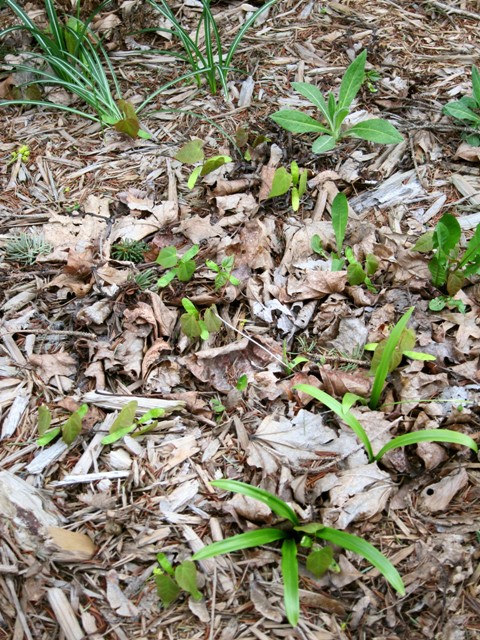No longer winter in my garden. Lots of things are growing now. Daffodils, tulips, windflowers, scilla. The winter aconite has shown its sunny face and fallen back asleep. My Virginia bluebells, dearest to my heart, are in full bloom. Even the autumn-blooming asters and echinacia have sent up foliage, to soak up sunlight and feed the roots and start their long-term plans.
Also, I have dandelions, and ragweed, and garlic mustard, and thousands of tiny maple tree seedlings. These things are growing just as rapidly and lushly. The ground is warm, the rain falls, the sun shines, and all the seeds sprout and seek to grow strong and bear fruit and replicate themselves.
My garden is meant to be a place set apart. That which grows in my garden is meant to be beautiful, to serve a purpose. If the garlic mustard grows, it will crowd out everything else. It will drop seeds, some of which will grow right away, others of which could lie dormant for years waiting an opportunity to grow. Letting one garlic mustard plant grow could mean losing the entire garden. If the maple seedlings, tiny now, are allowed to grow, they will demand all of the space and water and nutrients from the soil. They will shade the garden and grow so tall and wide that they will split the walkways, crowd the house, and the garden will be unrecognizable. And each of these will drop countless more seeds, intending to grow even more maple trees or garlic mustard plants.
I’ve heard it said that the best fertilizer for the garden is the gardener’s footprint. That is, all of my best hopes and desires and intent for my garden will mean nothing, if I don’t spend time walking in it, watching it carefully, learning to recognize the differences between my returning perennials and the invasive weed and tree seedlings.
I have to get the root of the weeds. If I pull too quickly, or when the ground is hard and dry, I’ll only strip the leaves, but the root will remain. The garden might look prettier for a while, but nothing has really changed underneath. Sometimes, pulling the leaves off but leaving the root, means that the roots continue to grow deeper and broader into the dirt. I can’t always tell this from the sprouting leaves, but if I do get it pulled, I can tell that this is a weed I’ve tried and failed to eradicate before.
The best way – the only way I know – to keep my garden as a place set apart, a place for beauty and purpose, is to spend time there, watching, looking closely, keeping the ground watered and easy to work, learning the plants which grow there, and pulling the weeds. They’re so much easier to pull when they’re small. Some of the big ones, the ones I ignored or neglected or didn’t spot soon enough, get deeply enough rooted that it takes a shovel to get them out – and that also digs up the flowers which grow around them.
And so I’m going to my covenant discipleship group today.





4 comments
Comments feed for this article
May 30, 2011 at 8:01 am
Penny
Your garden sounds and looks beautiful Jenn. Thought provoking! Keep getting those roots. Just like the children I teach – fix the surface and nothing really changes, get down to the roots of their challenging behaviour and worries and it fixes things for longer. Thanks for writing your blog, Penny x
June 18, 2011 at 1:37 pm
Work « djennerosity
[…] Spring in my garden is wonderful. New things bloom, everything is such a welcome relief from the colorless greys and browns and and white of winter. Seeing color appear – daffodils, bluebells, tulips – is exciting as new romance. Then the days get hot again, and I’d greatly prefer to leave the garden alone to do its own thing. I do not enjoy getting sweaty and mosquito-bitten and having dirt in my shoes. I would much rather sit in an air-conditioned house and drink tea (iced, now) and knit. […]
April 28, 2013 at 1:28 pm
p Shanks
what are those little seedlings you’ve pulled up?
April 28, 2013 at 1:55 pm
djennerosity
Those are the maple tree seedlings, which grow from those abundant “helicopter” seed pods.